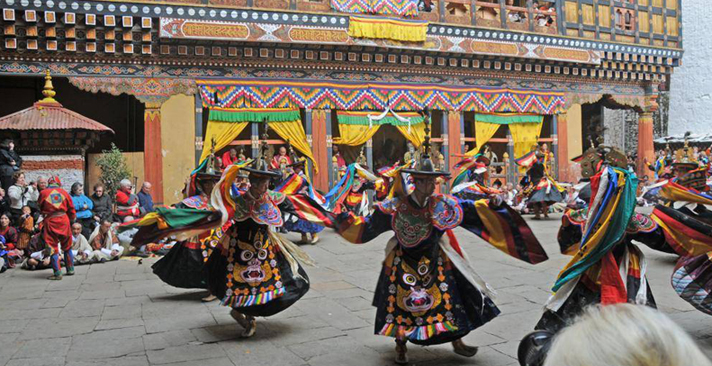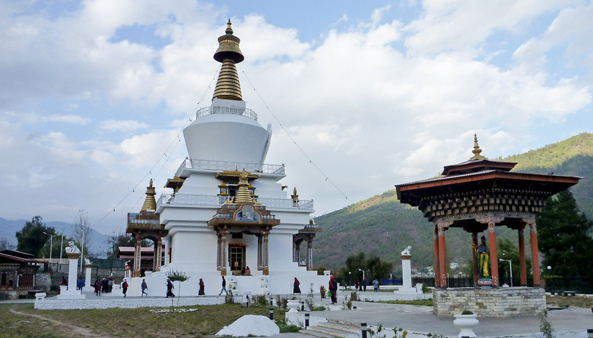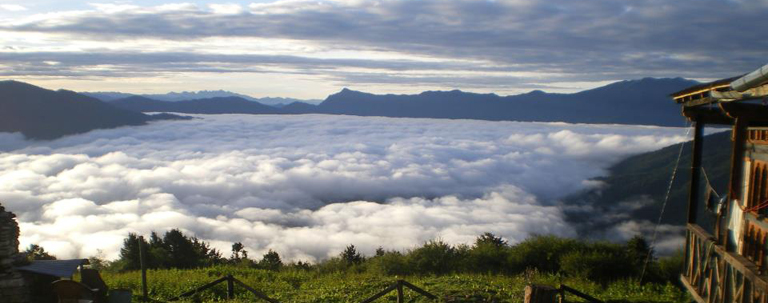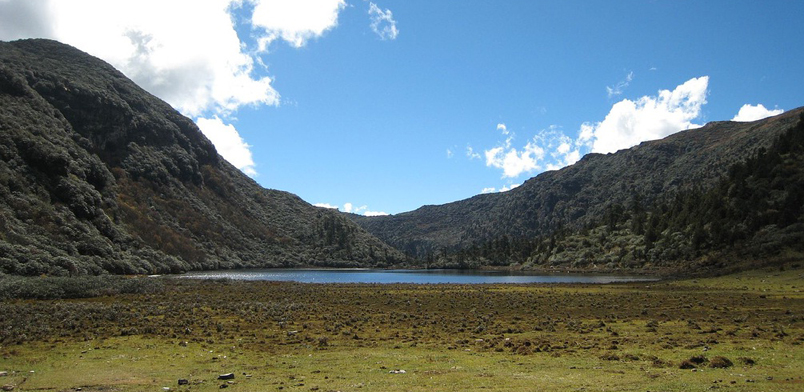
[ Thimphu Festival Tour | Thangbi Mani Festival Tour | Jambay Lhakhang Drup Tsechu Festival Tour | Black Crane Festival Phobjikha Tour | Punakha Domchey Festival Eight Nights Tour | Punakha Domchey Festival Ten Nights Tour | Chorten Kora Tsechu (arrive Paro, Depart Paro) | Chorten Kora Tsechu (arrive Paro, exit India) | Chorten Kora Tsechu (arrive India, exit Paro) | Gom Kora Tsechu (enter Paro, exit Paro) | Gom Kora Tsechu (enter Paro, exit India) | Gom Kora Tsechu (enter India, exit Paro) | Paro Tsechu Festival Tour | Paro Tsechu Festival 7 Dzongkhags Tour | Paro Tsechu Festival Tour with Druk Path Trek | Ura Yakchoe Festival Tour ]
Paro Festival Tour with Druk Path
Trekking
- 13 Nights 14 Days
- Western Bhutan
Dzongkhags covered: Paro, Thimphu, Wangduephodrang.
Duration: 13
Nights 14 Days
Trip Grade: Easy.
Day to Day Outline Itinerary:
Day 01: Arrive Paro
Day 02: Paro Tsechu Festival
Day 03: Paro Festival
Day 04: Paro - Thimphu
Day 05: Thimphu
Day 06: Thimphu - Wangduephodrang
Day 07: Wangduephodrang - Thimphu
Day 08: Thimphu – Phajoding (Trek Begins)
Day 09: Phajoding - Simkota Tsho
Day 10: Simkota Tsho - Jimilang Tsho
Day 11: Jimilang Tsho - Jangchu Lakha
Day 12: Jangchu Lakha - Jela Dzong
Day 13 Jela Dzong – Paro (Trek Ends)
Day 14: Depart Paro
Trip Overview:
Paro Tsechu: Tsechu or the religious festivals are usually the main tourist attractions for visitors. The Thimphu & Paro Festivals account for over 50 percent of the total arrivals; and certainly Paro Tsechu is the most popular one with its unique unfurling of the world’s biggest Thangka or Thongdrel ceremony. The pageantry is a unique experience like nothing you may have ever seen before. The festival commemorates deeds of the Great Saint Guru Rinpoche which are performed in the form of masked dances. The local folk attend these festivals to build merit. It is also a festive time for the locals who come dressed-up in their finest attire and dresses full of colour to socialise and make merry. This is not an event organised for tourists- it is an event that has been happening for centuries…”You may get the attention of the Atsara (clown), but the people won’t stare at you like elsewhere”.
This package combines Paro Tsechu with the Druk Path Trek which is the hike from Thimphu to Paro or vice versa.
Day 01: Arrive Paro
The flight to Paro crosses the Himalayan Mountains, giving you spectacular views of the awesome peaks, including the sacred Jhomolhari and Jichu Drakey peaks in Bhutan. Upon arrival in Paro, you will be greeted by the Bhutan Rebirth representative and taken to your hotel. In the afternoon, you can visit the Paro Rinpung Dzong. It was built in 1646 and now houses government offices and religious institutions, as do all the Dzongs (fortresses) currently. You will cross a traditional wooden bridge on the way to the Dzong. You can then tour the Tag Dzong which is also the National Museum, formerly the watch tower for the Dzong. It now houses a collection of fine arts, paintings, thangkas, statues, and antiques. Afterwards you will visit Kyichu Lhakhang, the oldest temple in the country. In the evening you can stroll through the Paro market and town. Overnight in Paro.
Day 02: Paro Tsechu Festival

After an early breakfast attend the first day of the Tshechu (above),
which is held in the ground of Rinpung Dzong. Lunch at the hotel. Evening:
relax at the hotel or stroll through Paro Town.
Day 03: Paro Festival
After lunch, you have two optional programmes: either attend the Tsechu or drive to Chelela pass, which is at an altitude of 3700 m offering a good view of Jhomolhari and Haa Valley. If you choose Chelela then you can also visit Kila Goemba (home for Buddhist nuns), which is nestled in a craggy patch on the mountainside below Chelela pass. It’s about one-hour walk amidst magnificent wooded area. Drive back to Paro. Evening relax.
Day 04: Paro - Thimphu
After breakfast hike to Taktsang (Tiger's Nest) Monastery, which is Bhutan's most famous monastery. Guru Rinpoche is said to have flown on the back of a tigress from Singye Dzong in Lhuentse to meditate in a cave where Taktsang Monastery now stands. It is perched on the edge of a steep cliff, about 900 metres above Paro Valley. The hike to reach the viewpoint to the Monastery makes for a nice half-day excursion. After lunch, drive to Thimphu. In the evening you can explore Thimphu, the Capital of Bhutan, and absorb the lifestyle of the people. You can also visit some interesting handicraft shops. Overnight in Thimphu.
Day 05: Thimphu Sightseeing
 After
breakfast you will visit the Memorial Chorten (On left- built
in memory of the Third King of Bhutan, Jigme Dorji Wangchuck) who
reigned from 1952-1972), Changangkha Monastery, the radio tower (for a
bird's eye view of Thimphu Valley and the Thimphu Dzong), and the zoo,
which contains the National Animal of Bhutan- the Takin. From there you
will visit the nunnery, the National Library (where ancient manuscripts
are preserved), and the School of Arts and Crafts (also known as the Painting
School). After a relaxing lunch, you will visit the National Institute
of Traditional Medicine, a traditional paper factory and Semtokha Dzong
(the oldest fortress in the Kingdom). Also visit the Tashichhodzong, ‘the
Fortress of the Glorious Religion’, which houses some Ministries,
His Majesty’s Secretariat, and the Central Monk Body. Overnight
in Thimphu.
After
breakfast you will visit the Memorial Chorten (On left- built
in memory of the Third King of Bhutan, Jigme Dorji Wangchuck) who
reigned from 1952-1972), Changangkha Monastery, the radio tower (for a
bird's eye view of Thimphu Valley and the Thimphu Dzong), and the zoo,
which contains the National Animal of Bhutan- the Takin. From there you
will visit the nunnery, the National Library (where ancient manuscripts
are preserved), and the School of Arts and Crafts (also known as the Painting
School). After a relaxing lunch, you will visit the National Institute
of Traditional Medicine, a traditional paper factory and Semtokha Dzong
(the oldest fortress in the Kingdom). Also visit the Tashichhodzong, ‘the
Fortress of the Glorious Religion’, which houses some Ministries,
His Majesty’s Secretariat, and the Central Monk Body. Overnight
in Thimphu.
Day 06: Thimphu - Wangduephodrang
After breakfast you will drive to Wangduephodrang, with a stop for tea at Dochula Pass (3,100 m), where on a clear day you can get spectacular views of the Himalayas. After lunch you will drive to Punakha, the former capital of Bhutan, and visit Punakha Dzong, which is noteworthy both for being one of the most beautiful Dzongs in Bhutan and also for having been built by the first Shabdrung (Great Unifier of Bhutan) in 1637. On the way back, you will stop at Metshina Village and take a 20 minutes walk through the rice fields to Chhimi Lhakhang of Lama Drukpa Kuenley (the Divine Madman). The Monastery is a fertility temple, where you may receive a special fertility blessing if you wish. It is said that so many people from all over the world who could not conceive have been blessed with a child after visiting this temple.
Day 07: Wangduephodrang - Thimphu
In the morning you will drive back to Thimphu. In the afternoon you can visit the Textile Museum and the Folk Heritage Museum. Or you can hike to Tango Monastery, which was built by the "Divine Madman" in the 15th century. It's a centre of study for monks, and it affords a great view of Thimphu Valley. On the grounds of the monastery is a "sin-testing" tunnel--it is said that if you have sinned, you will get stuck in the tunnel, and if you are without sin, you will go through with ease! Overnight in Thimphu.
Day 08: Trek Begins: Thimphu-Phajoding
(Altitude 3,870 m, Distance 8 km, time 4-5 hours). The trek is all uphill through forest, mostly bluepine, this first day. The camp is at Phajoding Monastery and you can walk around the area and see the monastery.

View of a cloud covered Thimphu from Phajoding
Day 09: Phajoding - Simkota Tsho
(Altitude 4,040 m, Distance 10 km, time 5-6 hours). The trail continues to climb for about an hour until you reach Phume La (pass) at 4,210 m. From here you will have a view of Gangkar Puensum, the highest mountain in Bhutan, as well as other Himalayan peaks. The trail then descends to Simkota Tsho ('Tsho' means lake), where the camp is located. It's possible to go trout fishing here if you wish.
Day 10: Simkota Tsho - Jimilang Tsho
(Altitude 3,880 m, Distance 11 km, time 5 hours). The trail will take you on short ups and downs and through a yak herders' camp. Before arriving at the camp, the trail will descend through dwarf rhododendrons. The camp is at Jimilang Tsho (Sand Ox Lake), where you will again have the chance to fish for giant trout, which the lake is known for. There is a good view of Jichu Drakey Mountain from here.

Jimilang Tsho on a fairly clear day on the trail. Jimilang Tsho
meaning ‘Sand Ox Lake’ was named after a bull that emerged
from the lake and joined the cattle of a family that used the area as
a grazing ground during the summer.
This lake has a pleasant camping place at its end hence is used by the
trekkers of Druk Path Trek to camp.
Day 11: Jimilang Tsho - Jangchu Lakha
(Altitude 3,780 m, Distance 11 km, time 5 hours). The trek will begin with an hour-long ascent, following the ridge above the tree line and then eventually descending. The camp is near a yak herders' camp, and there are lovely views of Jhomolhari Mountain from here. You may spot some pheasants in the area.
Day 12: Jangchhu Lakha - Jela Dzong
(Altitude 3,450 m, Distance 10 km, time 4-5 hours). There are many ups and downs above the tree line during the first half of the trail. The trail then descends through rhododendron and thick alpine forest to Jela Dzong and across Jela La (pass) at 3,490 m. You can visit the Dzong and explore the area. The camp is below the Dzong, in a yak pasture.
Day 13: Trek Ends. Jela Dzong – Paro
(Distance 10 km, time 4 hours). The trail today is all downhill, past some villages. The trail ends near the Tag Dzong in Paro. You will be met by your driver and driven to your hotel in Paro. In the evening you can visit a traditional farmhouse and, if you wish, enjoy a Bhutanese dinner. Overnight in Paro.
![]() Day
14: Depart Paro
Day
14: Depart Paro
Drive to Paro Airport for departure in the morning.
As festival times are the most popular times for visitors to come to Bhutan, flight seats and hotel rooms will be on high demand. Book early to avoid disappointment.
| |
BACK TO FESTIVAL TOURS MAIN PAGE |
